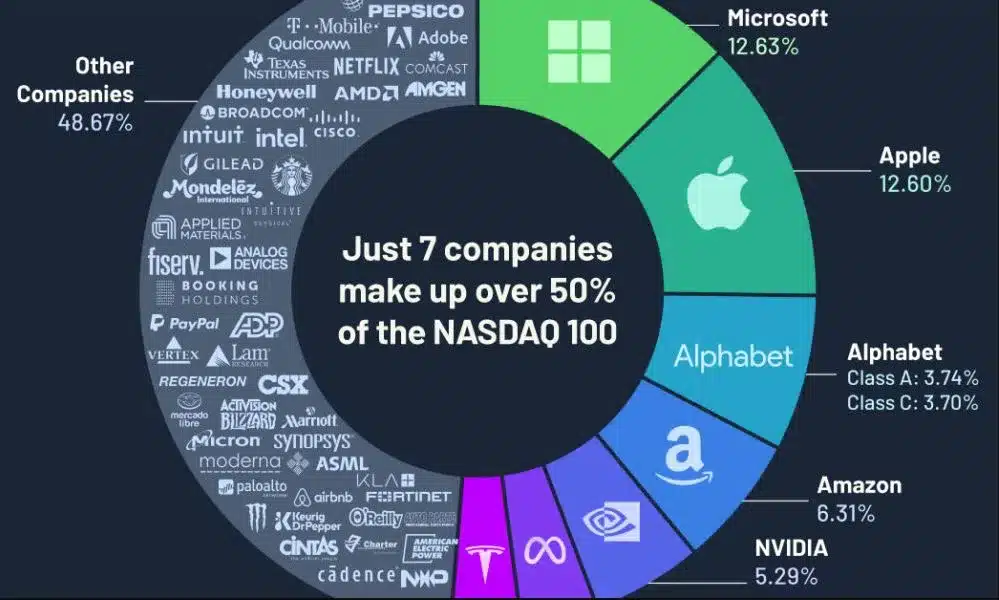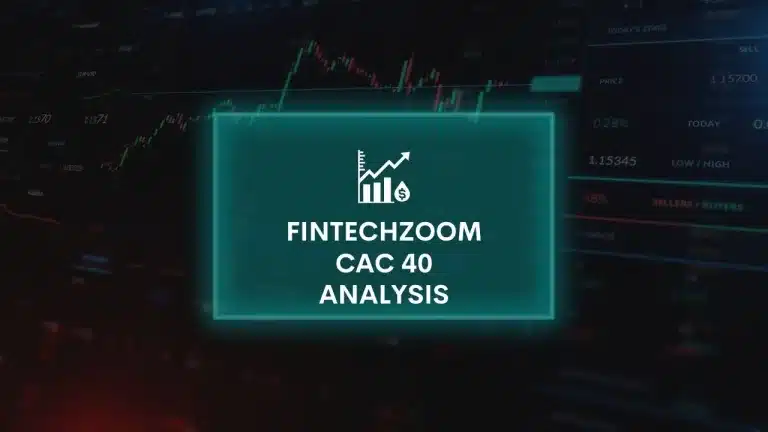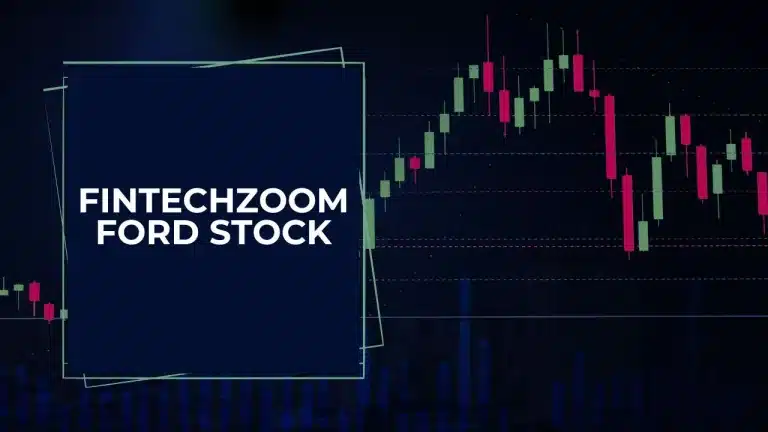Nasdaq Fintechzoom: Analysis and Forecast
In this article on Fintechzoom, we’ll completely analyze Nasdaq current performance, and the factors influencing it and provide you with a forecast. So, read this guide completely if you want to know about Nasdaq.
The Nasdaq Composite Index, a barometer of the technology sector and broader market trends holds a pivotal position in the global financial landscape. Renowned for its heavy concentration of tech giants, it serves as a crucial indicator of technological prowess and market sentiment. As we delve into 2024, understanding Nasdaq’s trajectory is more relevant than ever, given its substantial impact on investment strategies and economic forecasts.
In the preceding year, Nasdaq displayed resilience amidst varying market pressures, including fluctuating interest rates and geopolitical tensions. Despite these challenges, it managed to sustain a relatively stable performance, underscoring the robust nature of the technology sector and its lesser correlation with traditional economic downturns. This performance sets the stage for a detailed analysis of its potential path in 2024, focusing on the underlying factors that could drive its movements.
As we move forward, in this article, we’ll discuss factors that contribute to the Nasdaq’s performance, including the influence of heavyweight companies within the index, external economic factors, and the broader technological advancements shaping the industry. By examining these elements, investors and analysts alike can gain a nuanced understanding of what might lie ahead for this crucial index.
Fintechzoom Nasdaq Analysis

As of early 2024, the Nasdaq Composite Index has been a beacon of stability and potential growth, influenced heavily by the performance of major tech companies like Tesla, Microsoft, and Alphabet. In the first quarter of 2024 alone, the index saw a rise, largely buoyed by optimistic earnings forecasts and strong performance from these tech behemoths. Notably, Microsoft and Alphabet have reported revenue increases that exceeded market expectations, providing a substantial boost to the index.
The index’s resilience is further evident when considering the broader economic landscape. Despite a volatile geopolitical climate and the Fed’s adjustments to interest rates, the Nasdaq has managed to maintain an upward trajectory. This is indicative of the strong demand for technology solutions and digital infrastructure, which continue to dominate market trends. Moreover, the index’s performance is less correlated with traditional economic downturns, suggesting a decoupling from usual market pressures that affect other indices more significantly.
Furthermore, Nasdaq’s stability can be attributed to its diverse technology portfolio, which includes companies at the forefront of innovation in AI, cloud computing, and biotechnology. This diversity not only cushions the index against sector-specific downturns but also positions it well for sustained growth as these technologies become increasingly integral to economic and social infrastructures.
Which Factors Influence Nasdaq?
The trajectory of the Nasdaq in 2024 is shaped by a constellation of pivotal factors, ranging from macroeconomic influences to specific industry dynamics within the technology sector. One of the most critical factors is the Federal Reserve’s monetary policy. The Fed’s approach to interest rates, which influences liquidity and borrowing costs, plays a fundamental role in the valuation of tech stocks. A looser monetary stance could facilitate greater growth and higher valuations for companies listed on the Nasdaq, whereas tightening could pose challenges.
Another significant influence is the ongoing U.S.-China relations, particularly how they affect technology giants like Nvidia and Apple, which are heavily reliant on global supply chains and international markets. Any escalation in trade tensions or restrictive policies could impact these companies’ operations and, by extension, their stock performance on the Nasdaq.
Additionally, the integration of advanced technologies such as artificial intelligence and blockchain into corporate operations and consumer markets continues to drive the Nasdaq’s performance. Companies at the forefront of these innovations, like those involved in cloud computing and AI, are likely to see continued investor interest, which could propel the index further.
Finally, the overall health of the global economy, including consumer spending and corporate investment, will influence the performance of the Nasdaq. Tech companies, especially those with a global footprint, are sensitive to shifts in economic conditions, making broader economic indicators a crucial area of focus for investors.
Fintechzoom Technical Analysis and Future Predictions of Nasdaq
The Fintechzoom technical outlook for the Nasdaq in 2024 is cautiously optimistic, with several analysts predicting a continuing upward trend following a robust performance in the previous years. Technical chart analysis shows the Nasdaq-100 testing significant resistance levels from January 2022, after a 7-week rally brought the index to new record highs. The absence of immediate resistance in the price charts suggests the potential for further rises, indicative of strong investor confidence and increasing buy interest among market participants.
Long-term chart patterns from the past two decades reveal a resilient uptrend in the Nasdaq, with periodic corrections typically followed by strong recoveries, supporting a positive outlook. These patterns indicate that, despite likely short-term pullbacks, the long-term trajectory points upward. Strong technical indicators, such as a high Relative Strength Index (RSI), reinforce this view. The high RSI, while suggesting stocks may be overbought in the short term, also demonstrates strong upward momentum.
Looking forward to the rest of 2024 and beyond, projections are largely positive, with some Fintechzoom analysts suggesting that the Nasdaq could reach new all-time highs. This bullish scenario hinges on the sustained growth of key sectors like technology and biotech, further fueled by advancements in AI and other innovative technologies.
However, it’s important to consider potential risks that could invalidate this optimistic outlook. Economic indicators such as inflation rates and global economic slowdowns could lead to market volatility, impacting tech stocks that are heavily represented in the Nasdaq.
Fintechzoom Investment Strategies for Nasdaq
Given the optimistic Fintechzoom forecasts and strong technical indicators for the Nasdaq, investors may consider several strategies to capitalize on potential market movements. A focus on growth stocks, particularly in the technology sector, remains a viable strategy. Companies leading in AI, cloud computing, and biotechnologies are poised for significant growth, making them attractive investment targets. Investors should look for companies that are not only industry leaders but also have solid fundamentals and strong future growth prospects.
Diversification across different technology sub-sectors could also mitigate risk. While tech stocks may perform well, they are often volatile. Spreading investments across various sub-sectors such as semiconductor, software, and biotech can help balance the risk while still capitalizing on the growth potential of the broader tech industry.
For those with a more conservative approach, exchange-traded funds (ETFs) that track the Nasdaq-100 index could provide a less volatile entry point into the market. ETFs offer the advantage of built-in diversification and lower risk compared to individual stock investments, while still allowing investors to benefit from the overall upward trend of the market.
Finally, given the potential for short-term volatility due to geopolitical tensions and economic policy changes, maintaining a flexible investment strategy with a ready cash reserve could allow investors to take advantage of buying opportunities during dips in the market.
These strategies, combined with continuous monitoring of market conditions and regular portfolio adjustments, can help investors navigate the uncertainties of 2024 and potentially yield significant returns from the Nasdaq market.
Challenges and Risks
Investing in the Nasdaq, while promising, comes with its set of challenges and risks that could impact its performance in 2024. One of the main risks involves the ongoing geopolitical tensions, particularly between the U.S. and China. These tensions could affect the global supply chains and international sales of major tech companies, impacting their stock prices and overall market stability.
Economic policies, especially those related to interest rates and inflation, also pose a significant risk. The Federal Reserve’s policies on interest rates will directly influence investment in tech stocks, as changes in these rates can affect borrowing costs and consumer spending. High inflation could erode purchasing power and reduce consumer demand for products and services offered by companies within the Nasdaq.
Another risk comes from market saturation and competition within key tech sectors. As more companies innovate and enter the market, especially in high-growth areas like AI and biotech, there could be increased pressure on prices and profit margins for established players. This could lead to volatility in their stock prices and affect the overall performance of the Nasdaq.
Finally, regulatory changes, particularly those targeting big tech companies concerning data privacy, market dominance, and antitrust issues, could lead to fines, restrictions, or changes in business practices that might negatively impact these companies’ valuations.
Investors should consider these risks and maintain a strategy that includes due diligence, regular market reviews, and possibly hedging against potential downturns to navigate through 2024 effectively.
Frequently Asked Questions (F.A.Q)
What are the Fintechzoom recommended investment strategies for the Nasdaq?
For 2024, Fintechzoom experts recommend diversifying investment portfolios by incorporating ETFs that track major indices like the Nasdaq. This could include specific sector ETFs or broad-market ETFs depending on your investment goals. Additionally, considering the volatility in tech stocks, adopting a buy-on-dip strategy might be beneficial, especially in high-growth sectors such as technology and consumer discretionary, which can benefit from lower interest rates.
What risks should investors be aware of when investing in the Nasdaq?
Investors should monitor geopolitical tensions and their impacts on international markets, especially how U.S.-China relations might affect tech giants. Economic policies, particularly those related to interest rates and inflation, are also crucial as they directly impact tech stock valuations. Regulatory changes targeting big tech companies around antitrust issues and data privacy could also pose risks.
How can new investors get started with investing in the Nasdaq?
New investors can start by choosing a reliable broker or trading platform that allows access to Nasdaq stocks and ETFs. Opening a stock trading account and beginning with small investments in ETFs that track the Nasdaq can be a good starting point. It’s important to invest according to one’s financial goals and risk tolerance.
Wrapping Up
As we look ahead to 2024, the investment landscape for the Nasdaq presents both opportunities and challenges. With the possibility of continued bullish trends in tech and consumer sectors, strategies like diversification and buying on dips could be advantageous. However, staying informed about potential risks—from geopolitical shifts to economic policies—is crucial for capitalizing on investments while mitigating losses. Keeping these strategies and considerations in mind will help investors navigate the complexities of the Nasdaq market in the coming year.







